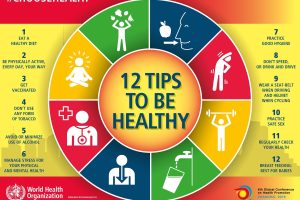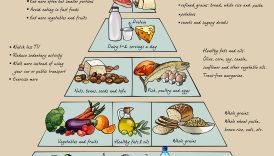Healthy Living Made Easy: Following CDC Guidelines

We all lead busy lives, often balancing work, family, and personal commitments. In the midst of our hectic schedules, prioritizing health and wellness can sometimes take a back seat. However, implementing effective health strategies is essential for a better quality of life. Following the guidelines set by the Centers for Disease Control and Prevention (CDC) can significantly impact how we manage our everyday health.
- Healthy Living Made Easy: Following CDC Guidelines
- Why Focus on Health?
- A Healthier Future Starts Today
- Understanding CDC Guidelines
- Importance of CDC Guidelines
- Key Recommendations
- Nutrition Tips for a Healthy Lifestyle
- Balanced Diet
- Meal Planning
- Physical Activity and Exercise
- Benefits of Exercise
- Simple Workouts to Try
- Mental Health and Well-Being
- Stress Management Techniques
- Importance of Sleep
- Hygiene Practices for Disease Prevention
- Hand Washing
- Cleaning and Disinfecting
- Vaccinations and Preventive Health Measures
- Importance of Vaccinations
- Health Screenings to Consider
- Creating a Healthy Home Environment
- Indoor Air Quality
- Safety Measures
- Social Connections and Support Systems
- Building Relationships
- Community Resources
- Implementing CDC Guidelines in Daily Life
- Setting Realistic Goals
- Overcoming Challenges
Why Focus on Health?
Just like maintaining a car requires regular check-ups and fuel, our bodies require consistent care and attention. A good friend of mine once neglected her health for years, thinking she could catch up later. Unfortunately, she faced significant health challenges that could have been prevented. This experience serves as a reminder of the importance of proactive health measures.
A Healthier Future Starts Today
To guide individuals on their journey toward better health, we’ll explore:
- CDC guidelines and their relevance
- Nutrition tips for building a sturdy foundation
- The benefits of physical activity
- Mental health importance
By adopting these strategies, anyone can pave the way for a healthier future. Let’s dive into understanding and implementing these essential guidelines!
Understanding CDC Guidelines
As we take our first steps toward a healthier lifestyle, it’s essential to grasp what the CDC guidelines entail. These guidelines serve as a beacon of evidence-based practices that empower individuals to make informed health choices.
Importance of CDC Guidelines
The CDC guidelines are not just mere suggestions; they are vital roadmaps designed to enhance public health and prevent diseases. Consider a sports game—players need a strategy to win, much like we need a plan for our health. When my colleague followed the CDC recommendations on vaccinations, she safeguarded herself and her family against several illnesses. This kind of proactive approach reduces the risk of outbreaks and contributes to community health.
Key Recommendations
The CDC provides a wealth of recommendations, but here are some key points to consider:
- Stay Vaccinated: Immunizations protect not only yourself but also those around you.
- Practice Good Hygiene: Regular hand washing and cleanliness can prevent many diseases.
- Maintain a Healthy Diet and Exercise: A balanced lifestyle combats obesity and chronic diseases.
Understanding and applying these guidelines is essential in creating healthier communities. Let’s delve deeper into how nutrition can play a significant role in this journey!
Nutrition Tips for a Healthy Lifestyle
With a solid understanding of CDC guidelines under our belts, it’s time to focus on nutrition. A well-rounded diet is the cornerstone of good health, and making informed choices can lead to a vibrant lifestyle.
Balanced Diet
A balanced diet, rich in essential nutrients, plays a pivotal role in maintaining overall well-being. Think of your body as a car—only the best fuel can keep it running smoothly.
- Incorporate a Variety of Foods:Aim for different food groups:
- Fruits and vegetables
- Whole grains
- Lean proteins
- Healthy fats
My brother recently adopted a more balanced diet, including colorful fruits and veggies, and noticed significant boosts in his energy levels and mood.
Meal Planning
Meal planning can transform your approach to eating. By preparing meals in advance, you not only save time but also avoid the temptation of unhealthy options.
- Set Aside Time: Dedicate a day each week to plan meals.
- Create a Shopping List: Stick to this list to resist impulse buys.
- Try Batch Cooking: Prepare larger quantities and freeze portions for busy days.
With these tips, preparing nutritious meals can become not only manageable but enjoyable. Next, we’ll discuss how incorporating physical activity into your routine enhances these healthy habits!
Physical Activity and Exercise
Now that we have laid a solid foundation with nutrition, it’s time to shift our focus to physical activity. Exercise is a critical component of a healthy lifestyle and can profoundly impact both physical and mental well-being.
Benefits of Exercise
Engaging in regular physical activity offers a multitude of benefits. It’s not just about losing weight; it’s about enhancing overall quality of life. For instance, my friend enrolled in a local running club and found that consistent exercise helped her reduce stress and boost her confidence. Key benefits include:
- Improved Cardiovascular Health: Lower risks of heart disease and stroke.
- Enhanced Mood: Exercise releases endorphins, which help alleviate anxiety and depression.
- Increased Energy Levels: Regular activity helps improve stamina and vitality.
Simple Workouts to Try
You don’t need a gym membership to stay active! Here are some simple workouts to get you started:
- Walking: Aim for 30 minutes a day. It’s low-impact and easy to fit into most schedules.
- Bodyweight Exercises: Try squats, lunges, and push-ups at home.
- Yoga or Stretching: Great for flexibility and mindfulness.
Incorporating physical activity into daily routines not only complements a healthy diet but greatly enhances overall wellness. Next, we’ll explore the importance of mental health and well-being!
Mental Health and Well-Being
Having addressed the significance of physical activity, it’s crucial to turn our attention to mental health and well-being. In today’s fast-paced world, managing stress and ensuring proper rest are vital components of overall health.
Stress Management Techniques
We all encounter stress, but it’s how we manage it that truly counts. Implementing effective stress management techniques can transform your mental landscape. One of my friends took up meditation and found it to be a game changer for her anxiety. Consider these practical techniques:
- Mindfulness Meditation: Spend even just 10 minutes a day focusing on your breath.
- Physical Activity: Remember, exercise can significantly lower stress levels.
- Journaling: Writing down thoughts and feelings can provide clarity and outlet.
Importance of Sleep
Equally important is the role of sleep in promoting mental well-being. Quality sleep rejuvenates the mind and body. I noticed a stark difference in my concentration and mood when I committed to getting 7-8 hours of sleep each night. Here’s why sleep matters:
- Cognitive Function: Good sleep enhances memory and decision-making.
- Emotional Stability: Insufficient sleep can lead to mood swings and irritability.
- Physical Health: Poor sleep is linked to various health issues, including obesity and heart disease.
By prioritizing stress management and quality sleep, individuals can significantly boost their mental wellness. Next, we will discuss hygiene practices essential for disease prevention!
Hygiene Practices for Disease Prevention
Now that we’ve covered mental health and well-being, it’s essential to shift our focus to hygiene practices that play a crucial role in disease prevention. Maintaining good hygiene helps safeguard not only individual health but also community well-being.
Hand Washing
One of the simplest yet most effective hygiene practices is hand washing. It may seem trivial, but proper hand hygiene can significantly reduce the spread of infections. I remember when my son started kindergarten; teaching him the importance of hand washing before meals and after playing outdoors was key in keeping him healthy. Here’s how to wash your hands effectively:
- Wet Hands: Use clean water (warm or cold).
- Apply Soap: Lather well, covering all parts of your hands.
- Scrub for 20 Seconds: Don’t forget areas often missed, like between fingers and under nails.
- Rinse and Dry: Use a clean towel or let them air dry.
Cleaning and Disinfecting
Equally important is thorough cleaning and disinfecting of surfaces in our homes. Germs can linger on surfaces for hours or even days, so regular cleaning is vital. A friend of mine started a weekly cleaning schedule that significantly reduced the illness in their household. To keep your space germ-free:
- Identify High-Touch Areas: Focus on doorknobs, light switches, and countertops.
- Use Appropriate Cleaners: Disinfectants are effective against a wide range of pathogens.
- Establish a Routine: Make cleaning a regular part of your schedule to ensure it doesn’t become overwhelming.
By adopting these hygiene practices, everyone can contribute to a healthier environment. Next, we’ll discuss vaccines and preventive health measures to further enhance our well-being!
Vaccinations and Preventive Health Measures
With a firm grasp on hygiene practices, let’s delve into vaccinations and other preventive health measures. These components are crucial for protecting individual and community health, and they work hand-in-hand with the strategies we’ve covered so far.
Importance of Vaccinations
Vaccinations play a pivotal role in preventing diseases that once posed significant threats to public health. I vividly remember getting my flu shot every year; it’s a small price to pay for a shield against potential illness. Benefits of vaccinations include:
- Herd Immunity: Protects vulnerable populations who cannot be vaccinated.
- Reduction of Disease Spread: Vaccinated individuals help lower the outbreak risks.
- Long-Term Healthcare Savings: Preventive measures can decrease overall healthcare costs.
Health Screenings to Consider
In addition to vaccines, regular health screenings are essential for early detection and prevention of diseases. Scheduling routine screenings helped my mother identify a health issue early, which significantly improved her treatment outcome. Here are important screenings recommended at various life stages:
- Blood Pressure Checks: Regular checks help detect hypertension.
- Cholesterol Levels: Essential for monitoring heart health.
- Cancer Screenings: Mammograms, colonoscopies, and other screenings depend on age and risk factors.
By prioritizing vaccinations and health screenings, individuals can take significant strides toward a healthier future. Next, we will explore how to create a healthy home environment!
Creating a Healthy Home Environment
Having looked into vaccinations and preventive measures, creating a healthy home environment is the next essential step in supporting well-being. A safe and clean home is not just a sanctuary; it’s a foundation for a healthy lifestyle.
Indoor Air Quality
One often-overlooked aspect of a healthy home is indoor air quality. I’ve seen the positive effects of improved air quality in my own home after adding air purifiers and houseplants. Fresh air can significantly influence overall health by reducing allergens and pollutants. To enhance indoor air quality:
- Ventilation: Open windows regularly to let fresh air circulate.
- Indoor Plants: Incorporate plants like snake plants or pothos, known for their air-purifying properties.
- Avoid Smoking Indoors: Tobacco smoke can linger and adversely affect everyone in the household.
Safety Measures
In addition to air quality, implementing safety measures ensures that your home is a secure space. After a minor accident with my child, I realized the need for more vigilance regarding safety. Key safety measures include:
- Childproofing: Install safety gates and cabinet locks if you have young children.
- Smoke and Carbon Monoxide Detectors: Regularly check and replace batteries to ensure they’re functional.
- Emergency Preparedness: Keep a first aid kit and have an emergency plan in place.
With these steps, you can create a healthier and safer home environment. Next, let’s discuss the importance of social connections and support systems for holistic wellness!
Social Connections and Support Systems
Having established a healthy home environment, it’s critical to explore the importance of social connections and support systems. Relationships and community bonds can significantly enhance mental well-being and provide a safety net in challenging times.
Building Relationships
Cultivating close relationships is fundamental for emotional health. For instance, when I moved to a new city, I took the initiative to attend local meetups. It was intimidating at first, but forging new friendships helped me feel more connected and supported. Here are some ways to build relationships:
- Join Clubs or Groups: Engage in hobbies such as book clubs, sports teams, or volunteer organizations.
- Stay in Touch: Regularly check in with family and friends to strengthen those connections.
- Be Open and Approachable: Sharing experiences can foster deeper bonds with others.
Community Resources
Beyond personal relationships, community resources are invaluable. During a tough period, I discovered local support groups that provided guidance and camaraderie, significantly easing my burden. Consider utilizing community resources like:
- Local Health Organizations: Access workshops and programs focused on wellness.
- Support Groups: Whether for specific health issues or general emotional support, these can provide essential guidance.
- Social Services: Explore services that offer assistance with housing, nutrition, and more.
By nurturing social connections and leveraging community resources, individuals can enhance their overall well-being. Our final section will focus on implementing CDC guidelines in daily life to create sustainable health habits!
Implementing CDC Guidelines in Daily Life
Having explored the importance of social connections and community resources, it’s time to look at how to effectively implement CDC guidelines into daily life. Making these practices a routine can seem daunting, but with focus and intention, you can achieve sustainable health habits.
Setting Realistic Goals
The first step towards implementation is setting achievable goals. Rather than aiming for dramatic changes, I found success in creating small, realistic objectives. For instance, instead of committing to a full workout routine immediately, I started with a 10-minute walk each day, gradually increasing my time as it became a habit. Here are tips for setting realistic goals:
- Be Specific: Rather than saying, “I’ll eat healthier,” try “I’ll include at least one vegetable with each dinner.”
- Track Progress: Use a journal or app to monitor your accomplishments, no matter how small.
- Celebrate Milestones: Acknowledge your progress to stay motivated!
Overcoming Challenges
Obstacle-free living is rare, but overcoming challenges is vital to maintaining health goals. I encountered numerous hurdles, from busy schedules to torn motivation, but learning to navigate them has strengthened my resolve. Consider these strategies:
- Identify Triggers: Recognize situations that lead to unhealthy choices, like stress or boredom, and plan alternatives.
- Seek Support: Share your goals with family or friends who can help hold you accountable.
- Be Flexible: Adjust your goals as needed, allowing for grace without dropping the whole plan.
By setting realistic goals and learning to overcome challenges, individuals can effectively integrate CDC guidelines into their daily routine for a healthier lifestyle. This journey is ongoing, but each step taken brings us closer to a healthier, more vibrant future!





